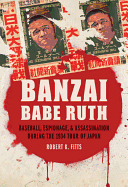
On November 2, 1934, half a million baseball fans screamed wildly for a motorcade headed by Babe Ruth. New York City, right? No: Ginza, Japan. They were screaming "Banzai Babe Ruth" (hurrah) to welcome an All-American all-star team that also included Lou Gehrig, Lefty Gomez and a late addition, a mediocre catcher named Moe Berg (who would later spy for America during World War II). They were on a month-long, 18-game tour of Japan, a nation that had fallen in love with baseball in the late 19th century. But there was more at stake in these games than the runs scored. Robert K. Fitts (Remembering Japanese Baseball) describes it all in Banzai Babe Ruth as "a tale of international intrigue, espionage, attempted murder, and, of course, baseball."
Japan and the United States were moving closer to war, and both sides thought a goodwill tour like this could help alleviate tensions. Even as the players took the field, though, officers at Japan's Imperial Japanese Academy were planning to overthrow the government, while Tokyo's War Gods Society planned to kill the tour's organizer, Matsutaro Shoriki, the father of Japanese baseball. The first game was played in Tokyo before 60,000 fans; the home team lost 17-1, setting the tone for the rest of the series. Fitts is excellent at capturing occasional bouts of dissension among the American players, describing the respectable quality of play by their Japanese opponents, and especially at capturing the ominous atmosphere that surrounded the tour. Fans will love the stats and player photos, too! --Tom Lavoie, former publisher

